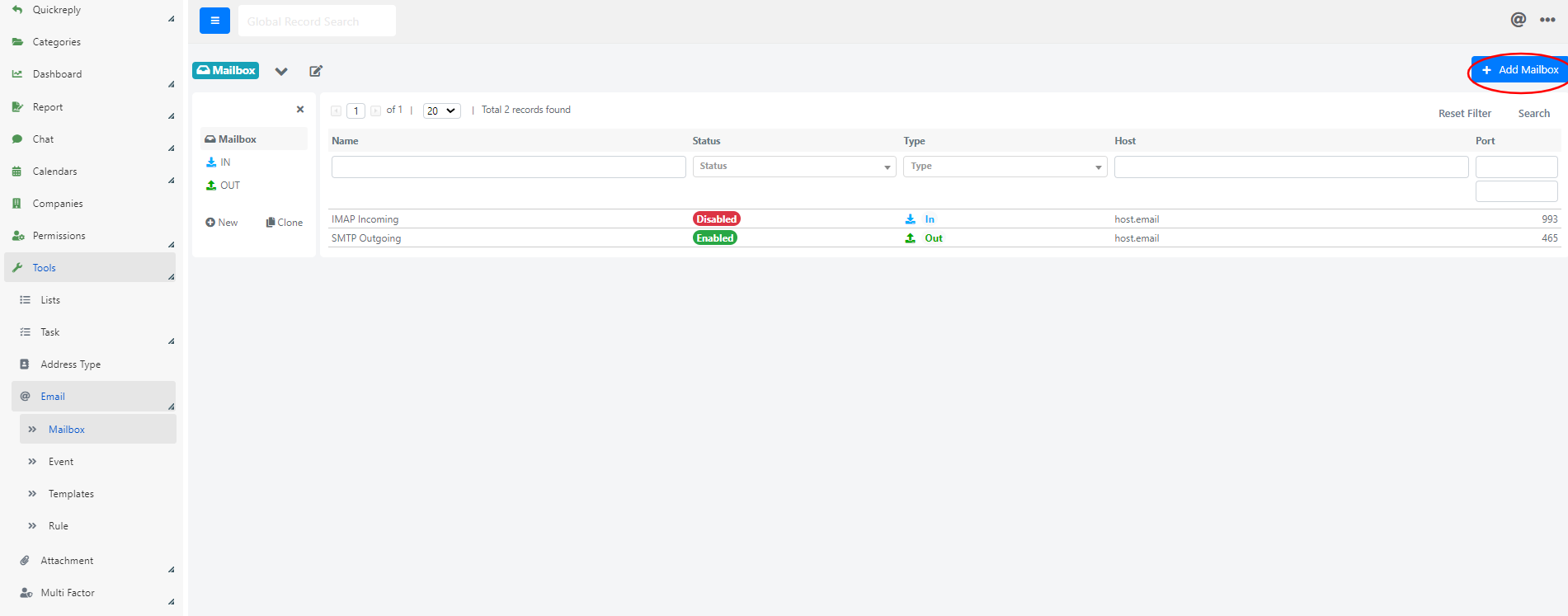Configuring an Outgoing Mailbox
Mailboxes are one of the fundamental entities in email integration.
In order to send emails to your users, in fact, you need to define an outgoing mailbox, in this guide we are going to explain the procedure for its setup.
CONFIGURATION
To configure a mailbox in Deepser, in the backend navigation menu, navigate to the System->Tools->Email->Mailbox section.
The grid in this section shows mailboxes already configured in Deepser.
To configure a new mailbox click on the ‘+ Add Mailbox‘ button in the top right corner.
At this point the mailbox configuration form will open.
Once the mailbox type has been set, in this case ‘OUT‘, all fields for the outgoing mailbox configuration will be loaded dynamically.
The fields in the form have the following meaning:
| TAB | FIELD | MEANING |
| GENERAL DATA | Name | Name of the mailbox. It is a descriptive field used in the system to display the mailbox. |
| Type | IN or OUT (IN to receive emails, OUT to send emails). | |
| Status | If “Disabled” the email integrations will not be active. | |
| Email Display | The displayed email address. It is not the username. The username is used to access the email, this field is only the displayed email address if our server allows us to use a different email address for the outgoing messages. | |
| Display Name | The name displayed in the “From” field of the emails (eg: Your Service Desk). | |
| Host | The address of the mailserver. It depends on your provider or mailserver. | |
| Door | Port for the connection to the mailserver. | |
| Encryption | Encryption of the connection to the mailserver. It depends on your provider or mailserver. | |
| User Name | User name (usually the email address) to connect to our mailbox. | |
| Password | Password to connect to our mailbox. | |
| Protocol | Protocol to send emails (SMTP or OWA). It depends on your provider or mailserver. | |
| OAuth Client | OAuth2 client used for the authentication on services that require it. | |
| SITEMA DATA | Prefix | It’s the prefix to prepend to the unique field of the record (usually the ID) sent by email. The Prefix is mainly used in the Subject of the email by the incoming integration (mailbox IN), to tell Deepser if it has to create a new record or to update an existing one. To give an example, if we are sendind an email for a Service Operation record, we can define that the prefix is “TICKET#”. By doing so, the emails will be sent with the subject “TICKET#ID” (where ID is the unique number of the Service Operation). If the user answers that email must not delete this text, to make Deepser aware of the record the email is referring to. |
| Allowed Emails | It tells if emails can be sent only to users registerd in the system or to any email address. | |
| Is Default Outgoing | It tells if the email is the default to send notifications. Deepser lets configure an infinite number of mailboxes, but the system needs to know which is the default one to send notifications. Every Service Operation record, for example, contains a field called Mailbox ID, that represents the email address to send the notifications for that record. If this field is not filled, then the emails will be sent using the Default Mailbox. | |
| Exclude Expression | In this field you can insert a regular expression in order to block emails whose recipients match the defined expression. | |
| ADVANCED | Custom Code | Custom PHP code executed after an email has been sent. It is possible to configure this field to trigger custom events. For example, if we wanted to update a counter of the reinders or update a specific entity of Deepser, we could exploit the customization of this field. |
Once the form has been filled and the configuration saved, click on the ‘Check‘ button, top right, to test the configuration.
If the mailbox has been configured correctly you will see a message of successful connection, otherwise an error message.






